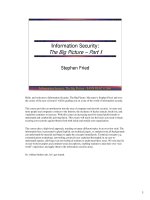Outsourcing information security
Bạn đang xem bản rút gọn của tài liệu. Xem và tải ngay bản đầy đủ của tài liệu tại đây (2.39 MB, 277 trang )
TLFeBOOK
Outsourcing Information Security
TLFeBOOK
For a complete listing of the Artech House Computer Security Series,
turn to the back of this book.
TLFeBOOK
Outsourcing Information Security
C. Warren Axelrod
Artech House
Boston • London
www.artechhouse.com
TLFeBOOK
Library of Congress Cataloging-in-Publication Data
A catalog record for this book is available from the Library of Congress
British Library Cataloguing in Publication Data
A catalog record for this book is available from the British Library.
Cover design by Igor Valdman
© 2004 ARTECH HOUSE, INC.
685 Canton Street
Norwood, MA 02062
All rights reserved. Printed and bound in the United States of America. No part of this book
may be reproduced or utilized in any form or by any means, electronic or mechanical, including
photocopying, recording, or by any information storage and retrieval system, without permission
in writing from the publisher.
All terms mentioned in this book that are known to be trademarks or service marks have been
appropriately capitalized. Artech House cannot attest to the accuracy of this information. Use of
a term in this book should not be regarded as affecting the validity of any trademark or service
mark.
International Standard Book Number: 1-58053-531-3
10 9 8 7 6 5 4 3 2 1
TLFeBOOK
To my own in-house support team: Judy, David, and Elizabeth
TLFeBOOK
.
TLFeBOOK
Contents
xv
Foreword
1
2
Preface
xix
Acknowledgments
xxv
Outsourcing and Information Security
1
First … Some Definitions
2
Second … A Clarification
2
Y2K as a Turning Point
3
The Post Y2K Outsourcing Speed Bump
5
Shaky Managed Security Services Providers
6
A Prognosis
7
The Information Security Market
8
References
9
Information Security Risks
11
Threats
11
From Internal Sources
11
From External Sources
13
vii
TLFeBOOK
viii
Outsourcing Information Security
3
4
Review of Threats
16
Vulnerabilities
17
Computer Systems and Networks
17
Software Development
17
Systemic Risks
18
Operational Risk
19
Operator and Administrator Risk
20
Complexity Risk
21
Life-Cycle Risk
21
Risks of Obsolescence
23
Vendor Viability Risk
24
Risk of Poor Quality Support
24
Conversion Risk
24
Risk of Dependency on Key Individuals
25
Summary
25
References
25
Justifying Outsourcing
27
Professed Reasons to Outsource
27
The Basis for Decision
28
Reasons for Considering Outsourcing
28
Cost Savings
29
Performance
35
Security
37
Expertise
40
Computer Applications
41
Support
43
Financial Arrangements
45
Summary
47
The Other Side of the Outsourcing Decision
48
References
48
Risks of Outsourcing
49
Loss of Control
49
TLFeBOOK
Contents
5
ix
Viability of Service Providers
50
Reasons for Abandoning Service
54
Relative Size of Customer
55
Quality of Service
56
Tangibles
56
Reliability
56
Responsiveness
57
Assurance
57
Empathy
57
Definitions
59
The Issue of Trust
59
Performance of Applications and Services
62
Lack of Expertise
63
Hidden and Uncertain Costs
63
Limited Customization and Enhancements
66
Knowledge Transfer
66
Shared Environments
67
Legal and Regulatory Matters
67
Summary and Conclusion
68
References
68
Categorizing Costs and Benefits
71
Structured, Unbiased Analysis—The Ideal
71
Costs and Benefits
72
Tangible Versus Intangible Costs and Benefits
72
Objective Versus Subjective Costs and Benefits
72
Direct Versus Indirect Costs and Benefits
73
Controllable Versus Noncontrollable Costs and Benefits
73
Certain Versus Probabilistic Costs and Benefits
73
Fixed Versus Variable Costs and Benefits
73
One-Time Versus Ongoing Costs and Benefits
74
Tangible-Objective-Direct Costs and Benefits
75
TLFeBOOK
x
Outsourcing Information Security
6
Tangible-Objective-Indirect Costs and Benefits
78
Tangible-Subjective-Direct Costs and Benefits
81
Tangible-Subjective-Indirect Costs and Benefits
81
Intangible-Objective-Direct Costs and Benefits
82
Intangible-Objective-Indirect Costs and Benefits
82
Intangible-Subjective-Direct Costs and Benefits
83
Intangible-Subjective-Indirect Costs and Benefits
83
Next Chapter
83
Reference
84
Costs and Benefits Throughout the Evaluation Process
85
Triggering the Process
85
Different Strokes
87
Analysis of Costs and Benefits
87
The Evaluation Process
91
Requests for Information and Proposals—Costs
94
Costs to the Customer
95
Costs to the Service Providers
96
Requests for Information/Proposal—Benefits
96
Benefits to the Customer
96
Benefits to the Service Providers
98
Refining the Statement of Work (SOW)
99
Service Level Agreement (SLA)
100
Implementation
101
Transition Phase
101
Transferring from In-House to Out-of-House
101
Monitoring, Reporting, and Review
104
Dispute Resolution
104
Incident Response, Recovery, and Testing
105
Extrication
105
Summary
105
References
106
TLFeBOOK
Contents
7
8
xi
The Outsourcing Evaluation Process—Customer
and Outsourcer Requirements
107
Investment Evaluation Methods
107
Including All Costs
109
Structure of the Chapter
111
The Gathering of Requirements
111
Business Requirements
112
Viability of Service Provider
116
Financial Analysis
116
Marketplace and Business Prospects
117
Health of the Economy
118
Marketplace Matters
118
Competitive Environment
119
Structure of the Business
120
Nature of the Business
121
Relative Sizes of Organizations
121
Service Requirements
123
Meeting Expectations
123
Concentration and Dispersion of Business Operations
and Functions
124
Customer View of Satisfactory Service
126
Technology Requirements
127
The “Bleeding” Edge
127
References
128
Outsourcing Security Functions and Security
Considerations When Outsourcing
131
Security Management Practices
134
Security Organization
134
Personnel Security
136
Other Human-Related Concerns of the Company
137
Ameliorating the Concerns of Workers
140
Asset Classification and Control
140
Information Security Policy
146
TLFeBOOK
xii
Outsourcing Information Security
9
Adopt Customer Policy
147
Adopt Service Provider’s Policy
147
Evaluate Responses to Due-Diligence Questionnaire
147
Enforcement and Compliance
147
Access Control and Identity Protection
149
Application and System Development
151
Operations Security and Operational Risk
152
Security Models and Architecture
153
Security Services—Framework
153
Security Infrastructure
153
Security Management and Control
154
Framework
154
Application to Service Providers
154
Physical and Environmental Security
155
Telecommunications and Network Security
156
Cryptography
158
Disaster Recovery and Business Continuity
159
Business Impact Analysis
159
Planning
159
Implementation and Testing
159
Legal Action
160
Summary
160
References
161
Summary of the Outsourcing Process—Soup to Nuts
163
Appendix A:
Candidate Security Services for Outsourcing
171
Appendix B:
A Brief History of IT Outsourcing
181
The Early Days
181
Remote Job Entry
182
TLFeBOOK
Contents
xiii
Time-Sharing
184
Distributed Systems
185
Personal Computers and Workstations
186
The Advent of Big-Time Outsourcing
187
The Move Offshore
188
And Now Security
189
Networked Systems and the Internet
190
The Brave New World of Service Providers
191
The Electronic Commerce Model
191
Portals, Aggregation, and Web Services
192
Straight-Through Processing (STP) and Grid Computing 194
Mobile Computing
194
References
195
Appendix C:
A Brief History of Information Security
197
The Mainframe Era
197
Isolated Data Centers
197
Remote Access
198
Distributed Systems
200
Minicomputers
200
Client-Server Architecture
201
The Wild World of the Web
202
The Wireless Revolution
205
Where IT Outsourcing and Security Meet
205
References
207
Selected Bibliography
209
Annotated References and Resources
209
Books
210
Newspapers, Journals, and Magazines
211
TLFeBOOK
xiv
Outsourcing Information Security
Computer-Related Publications
211
Security Publications
219
Business and Business/Technology Publications
220
Web-Based Resources
222
Web-Based Resources Related to Specific Publications
225
Conferences and Seminars
226
Publications from Professional Associations and
Academic Institutions
228
Government Sources: Legal and Regulatory
229
Vendors and Service Providers
231
Education and Certification
232
About the Author
235
Index
237
TLFeBOOK
Foreword
In the current knowledge age, business thrives on the confidentiality, integrity,
and availability of information. Information provides the nervous system in
which business operates. The task to secure business information is simpler in a
closed environment. However, our knowledge age is also one of outsourcing
business processes and services to reduce cost and streamline the organization.
In addition to those who are already taking advantage of outsourcing,
many other organizations are just beginning to consider the idea. The question
frequently asked, after how much money will be saved, is: How safe of a proposition is it to send mission-critical code and information (e.g., intellectual property, regulated data, private data) to another business entity? Organizations are
keen to understand how they can ensure the security of their code, data, compliance requirements, and intellectual property while still taking advantage of the
cost benefits.
The answer is that outsourcing is as secure as you make it. There are multiple levels of security—both from a process perspective and a technology perspective—which companies can put in place to secure their business relationships,
their data, and their intellectual property.
As companies allow business partners to access and process an increasing
amount of proprietary data, applications, and intellectual capital, they are realizing that not only must they get their business partners to commit to formalized
security measures and policies, but companies must also take steps to protect
themselves in the event that their business partners have a security breach.
With the current political turmoil and focus, this is particularly imperative
today in offshore vendor relationships. Certainly business partner security
breaches anywhere can be devastating, but the publicity given to offshore
xv
TLFeBOOK
xvi
Outsourcing Information Security
outsourcing makes a security breach offshore a potential customer, reputation,
and regulatory disaster.
While organizations need to address security in their business partner relationships, it is imperative to not go to the extreme and impose draconian controls that inhibit these relationships when it is unwarranted. The risk to
information varies depending on the nature of the information. Not all business
partner relationships warrant the same level of risk controls because the information and the nature of the relationships vary significantly.
The bottom line is that risk and business partner relationships vary and
that controls should be appropriate for the circumstances. Companies are only
as secure as their weakest link; in forming outsourcing relationships, keep the
following in mind:
• Don’t assume that “marquee clients” always equate to good security
partners.
• Don’t assume that IT service providers, even prestigious domestic ones,
will be good security partners.
• Ensure that business partners commit to formalized security measures
or policies, but companies also must take steps to protect themselves in
the event that their business partners have a security breach. Lax business partner or vendor security can negate a company’s entire investment in information security.
• Companies embarking on offshore outsourcing relationships should
use new relationships as a catalyst to formalize all their business partner
security processes.
This book provides valuable insight for organizations seeking an approach
to securing business partner relationships and will be a valuable tool for anyone
involved in outsourcing relationships, including information security and IT
managers, IT executives, and senior management in the organization. The risk
that organizations face in outsourcing extends to many parts of the business and
could significantly impact operations and reputations. The approach and
knowledge contained herein is a commendable work to present this to all interested parties.
By writing this book, Warren Axelrod specifically shows his experience to
provide an approach that will secure outsourcing relationships but is not steeped
in technology. While technology is important, Dr. Axelrod provides a very balanced risk-based approach to these relationships, an approach in which the
benefits of the relationship are balanced with risks and exposures that it
introduces.
TLFeBOOK
Foreword
xvii
The risk is clear. Business reputations can be affected by business partners—companies are only as trustworthy as the least reputable firms with which
they deal. Therefore, one security breach with one business partner cannot only
negate a company’s entire investment in information security, but it can also
damage the reputation and viability of a company. If companies cannot trust
their business partners and vendors, they should not be doing business with
them. In the case of IT outsourcing, companies may be better off internally supporting their IT systems than risking their support or development to thirdparty providers, at home or abroad.
Michael Rasmussen, CISSP
Principal Analyst, Information Risk/Compliance Management
Forrester Research, Inc.
September 2004
TLFeBOOK
.
TLFeBOOK
Preface
The idea for this book formed in 2001—a time when information technology
(IT) outsourcing was not at all the object of controversy, as it became in the
politically charged atmosphere of the United States in 2004. In fact outsourcing,
particularly offshore IT outsourcing, was seen as a boon and as having “saved
the day” with its contribution to preventing a computer meltdown during the
calendar change from 1999 to 2000—known variously as “Year 2000,” “Y2K,”
or the “Millennium date changeover.”
The book concept began when a colleague, Russell Dean Vines, a leading
author in the information security space, asked if I would write a book as one in
a series on security, which a publisher had asked him to put together. We agreed
that my book would address security aspects of IT outsourcing. This was appropriate for me since I have worked for IT outsourcing companies for more than
two thirds of my career and have specialized in information security since 1996,
earning a CISSP and CISM along the way.1
As luck would have it, Russ’s publisher decided to cancel the series. However, I was fortunate to have Artech House accept the proposal a short time later.
And the rest, as they say, is history.
1. The Certificate for Information Systems Security Professionals (CISSP) is awarded by the International Information Systems Security Certification Consortium (ISC)2 to those who can
demonstrate proficiency in the ten areas contained in the “body of knowledge.” The Certified Information Security Manager (CISM) is granted by the Information Systems Audit and
Control Association (ISACA) to those who have had substantial practical experience managing an information security function and who can demonstrate a required level of knowledge.
xix
TLFeBOOK
xx
Outsourcing Information Security
The Time Was Right
Looking into security aspects of outsourcing seemed timely because increasing
concerns were being voiced during the Y2K remediation period that foreign
outsourcers might be stealing intellectual property embodied in computer programs or injecting damaging code into computer programs for financial or
political gain. But, as Dan Verton points out in his revealing book, there was no
known evidence then or in the years that have followed that any such malfeasance has occurred [1].
In addition, lawmakers and regulators—in Europe and other countries,
such as the United Kingdom, Canada, and New Zealand, and later in the
United States—were increasingly reflecting the public’s concerns about identity
theft.2 In the United States, federal and state legislators in general, and regulators in the financial and health services industries in particular, voiced major
concerns that mirrored their constituents’ fears about the stealing of individuals’
personal information by those with evil intent. The regulators have already instituted extensive guidelines as to how to protect customers’ information as well as
that being handled by service providers, especially when such information may
be farmed out for processing abroad. The European Union is particularly
aggressive in this area.
The Intent of the Book
The goal of this book is to heighten your awareness of the many complex and
confusing issues that you need to identify, quantify (where possible), and analyze, if you are to make the right outsourcing decisions while ensuring that security matters have been fully addressed and accounted for. The content is not
intended to be all-encompassing, nor is it by any means the last word on the
subject. The goal is to bring to your attention, as it did to mine during the
research and writing processes, many items not typically included in analyses
but that, in some cases, change the whole basis of an outsourcing decision.
The central theme of the book is that organizations must understand and
consider what costs and benefits are incurred and gained, respectively, at the
intersection of the two most dynamic, difficult, and controversial areas of information technology today, namely, outsourcing and security. If we look at these
areas in a two-by-two table (see Table P.1), we see the full scope of the issues at
hand.
2. On November 15, 2001, I testified before Congress on cyber security. However, the congressmen at the hearing expressed much greater concern over the growing identity theft issue
than they did about the prospect of terrorists attacking through cyberspace.
TLFeBOOK
Preface
xxi
Table P.1
The Intersections of Outsourcing and Security
The Outsourcing
The Security
…of Outsourcing
Subcontracted IT services
Secure IT services
…of Security
Subcontracted security services
Secure security services
Now we will consider each box within the table to understand how it plays
within the overall concept.
The Outsourcing of Outsourcing
This refers to when an outsourcer subcontracts one or more IT services to
another service provider. The ultimate customer of the outsourcer may not even
be aware that this is occurring. But increasingly that question is being asked,
since the only way, for example, to be able to vouch for the protection of customer information is to know every pair of hands that has touched it or eyes that
have viewed it. While this issue is not a major focus of the book, an organization
must take it into account and include due diligence for providers to providers, to
whatever depth is necessary to ensure that every relevant point of contact has
been checked.
The Security of Security
Also, a lesser focus of the book, this subject relates to the security posture of
managed security services. In the physical world, it is a matter of ensuring that
security guards do not have criminal records. In the electronic world, it might
include a check as to how secure a particular manufacturer’s firewalls might be,
that is, whether it has any known vulnerability. In a real sense, the security of
security is the greatest risk of all, since so much reliance is placed on managed
security service providers (MSSPs). If they are corrupted—by design or by accident—the basic premise of security is thwarted.
The Outsourcing of Security
Here we are dealing with, for the most part, MSSPs. Appendix A includes an
extensive list of the types of security service available in the marketplace.
This is really a subset of general outsourcing, but it is a category that must
be looked at most carefully. It somehow combines both the above categories.
TLFeBOOK
xxii
Outsourcing Information Security
The security services provider may well use a third party to check on the backgrounds of its staff, or third parties may supply software and “signatures” to
facilitate the provider’s work. Consequently, there is reason for concern as to
how effective these once-removed services or subcontractors might be. This area
is addressed throughout the book. It is frequently offered as a more extreme
security situation relative to regular outsourcing, even critical services. Any risks
that relate to these services can put many of an organization’s activities at greater
risk.
The Security of Outsourcing
This subject represents the main focus of the book. It is the general case and, as
such, is subjected to all the concerns of the other entries in the table. It emphasizes the security issues that must be accounted for when making a decision to
outsource and when selecting a particular outsourcer. Many of these issues are
direct and specific to the provider of the services. But to the extent that the service provider relies on other providers for ancillary services, including security
services, then due consideration must also be given to the security postures of
these indirect service providers.
These dependencies, which have evolved over time, are on the verge of
potentially spiraling out of control. New technologies, in the form of Web services and grid computing, bring with them the specter of large numbers of
remote providers, many of whom may not be known to the user of the services.
In order to deal bravely with this “new world,” the analyst must be aware of the
issues and how to address them. Such is the foundation that this book attempts
to provide.
The Structure of the Book
Chapter 1 introduces our subject by defining the scope of the treatment of the
joint topics of outsourcing and security. It gives a definition of IT outsourcing
and traces the history of the recent rapid growth of such services. More detailed
and extensive histories of both outsourcing and information security are provided in Appendices B and C, respectively.
While it is true that there are many new outsourcing and security issues
and circumstances, many of these have been addressed in some form or another
in earlier times. We can take some of these lessons from the past and apply them
to the present and future. While appearances might be different, surprisingly
much is fundamentally the same. Deciphering the similarities and differences
makes for a much richer approach to current problems and many of the solutions can be tailored from past successes.
TLFeBOOK
Preface
xxiii
In Chapter 2, we lay out the range of information security risks that are
confronted daily, whether an activity is outsourced or not. Threats can come
from internal and external sources. Vulnerabilities arise in many areas with
many causes. It is hard enough to protect against threats and manage vulnerabilities for one’s own organization. How much more difficult it is to deal with
threats and vulnerabilities as they impact third parties and in turn affect the
security health of the customer of the services.
In Chapter 3, we look at the risks of outsourcing. The purpose is not to
discourage organizations from engaging third parties; rather it is to ensure that
the responsible parties have considered the risks, accounted for them, and after
going through the process, are more comfortable in their decision. Awareness is
important here. However, even when one thinks one knows all the risks, many
of them remain obscure—they are difficult or impossible to measure, yet their
impact can be enormous. This makes for some interesting subjective tradeoffs.
Clearly some decisions will be reversed—in either direction—by allowing for
these risk factors, but that is not a bad thing. It is far better to know what one is
getting into than to proceed blindly and find out later when bad things actually
happen.3
In Chapter 4, we get into greater detail and describe the categories of costs
and benefits. We differentiate between tangible and intangible, direct and indirect, and objective and subjective costs and benefits as they relate to outsourcing.
We provide examples of these costs and benefits, relating the categories specifically to risk and security areas.
Chapter 5 describes how the costs and benefits relate to the Request for
Information (RFI) and Request for Proposal (RFP) processes. The analysis is
done in the context of the status and viability of the outsourcing company,
which is a major consideration in the decision.
In Chapter 6, we look at the evaluation process that takes place once the
information has been collected and sorted. We consider issues that need to be
addressed, what should be included in the analysis, and the relative importance
of various items.
3. I am reminded of an industry newspaper report some 20 years ago of a major early player in
the computer industry, which purportedly decided it would withdraw from the computer
business based on a spreadsheet analysis that was later shown to contain a major error. Had
the correct analysis been done, it would have projected that this particular company would
have become a very profitable player in the business, as contrasted with the losing scenario
portrayed by the incorrect analysis. Errors of commission and omission can equally lead to
the wrong decisions. The goal here is to broaden the base of factors to be included in an
analysis to improve its accuracy and lead to better decisions. The reader is encouraged to add
factors of his or her own that I may have omitted and to check from many different angles to
ensure accuracy in the analysis.
TLFeBOOK
xxiv
Outsourcing Information Security
Chapter 7 delves into the specific security considerations that affect the
outsourcing decision and how they should be handled. It is here that we take
each of the categories usually ascribed to the field of security, map them to
aspects of the outsourcing decision process, and describe what influence they
might have. This is the crux of the book.
Finally, in Chapter 8, I summarize the full flow of the outsourcing evaluation and decision processes.
At the end of the book are three appendices. Appendix A is particularly
important as it evaluates the various candidate security services that might
be performed by a third party and shows their specific advantages and
disadvantages.
Appendices B and C contain histories of outsourcing and information
security, respectively. These provide the backdrop against which to view the current state of the art.
Reference
[1]
Verton, D., Black Ice: The Invisible Threat of Cyber-Terrorism, New York: McGrawHill/Osborne, 2003, p. 37.
TLFeBOOK









